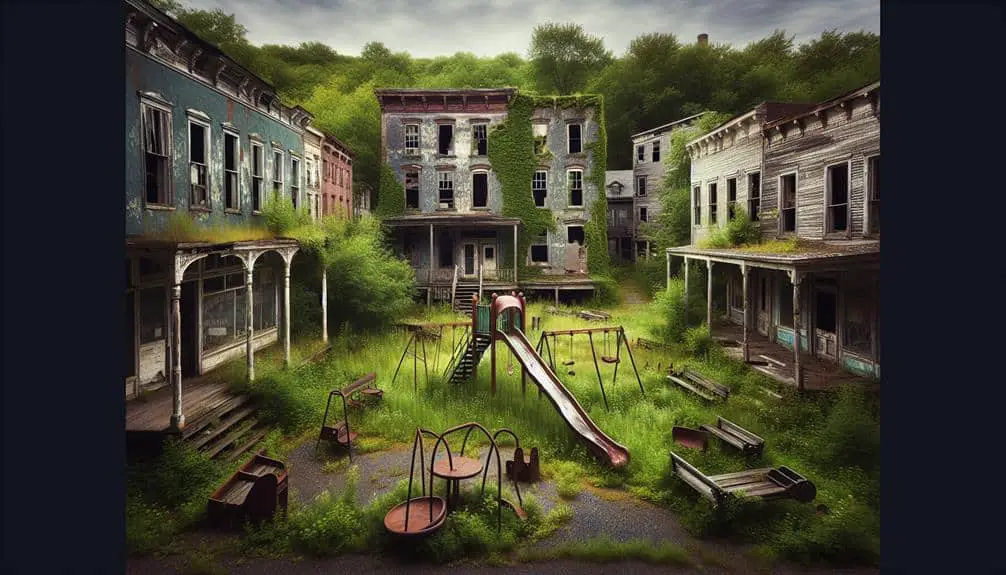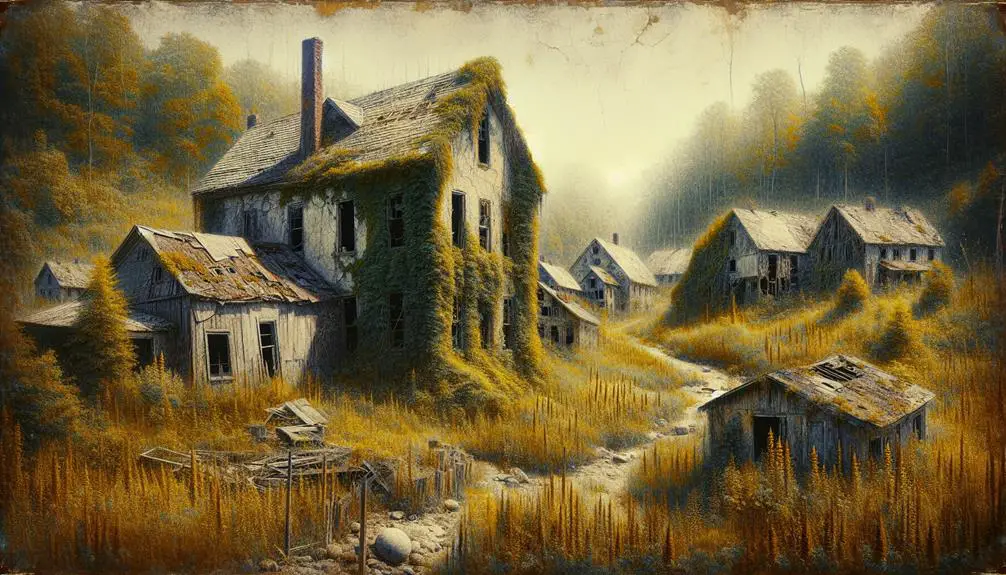Discover the remains of idealistic dreams turned into deserted realities. Visit New Harmony, where conflicting visions disrupted cooperative living. Explore the Shakers Community, struggling with dwindling numbers due to celibacy. Uncover the complex marriage practices of the Oneida Community that eventually led to its dissolution. Witness the cautionary tale of Icaria Speranza, facing internal conflicts and financial woes. Experience the spiritual enlightenment of the Koreshan Unity before its decline. These ghostly remnants of failed utopias in America's ghost towns offer a glimpse into ambitious endeavors that faltered. Venture further into the world of abandoned communal experiments.
Key Points
- New Harmony Community founded by Robert Owen in 1825 for social equality faced internal conflicts.
- Shakers Community promoted simplicity and communal living but dwindled due to celibacy policies.
- Oneida Community thrived with complex marriage practices but dissolved after internal conflicts.
- Icaria Speranza Community by French immigrants faced challenges and became a ghost town.
- Koreshan Unity Community, based on spiritual beliefs, declined due to disputes and external pressures.
The Rise and Fall of New Harmony
The rise and fall of New Harmony reveals a complex interplay of utopian ideals and practical challenges. Founded in 1825 by Robert Owen, this community aimed to create a perfect society based on cooperative living and social equality. At its core, New Harmony was built upon the belief that individuals working together could overcome societal injustices and disparities.
However, despite these lofty utopian ideals, New Harmony faced numerous obstacles related to community dynamics. Internal conflicts arose over differing visions of how the community should function, leading to divisions and discord among residents. The challenge of balancing individual freedoms with collective responsibilities also strained the fabric of the community.
Ultimately, the inability to reconcile these tensions contributed to the downfall of New Harmony. As residents grappled with the complexities of communal living, the community gradually dissolved, underscoring the delicate balance required to sustain utopian aspirations amidst the realities of human nature.
Failed Experiment: The Shakers Community
Amidst the landscape of American utopian experiments, the Shakers Community stands out as a failed venture in communal living. Founded on utopian ideals of equality, simplicity, and communal ownership, the Shakers aimed to create a harmonious society free from materialism and focused on spiritual devotion. However, their strict celibacy policies led to a dwindling population, ultimately causing the downfall of the community.
The Shakers believed in living a life of celibacy to achieve purity and focus on spiritual matters, but this also meant that they couldn't have children to sustain their community. As members aged and passed away, recruitment became increasingly challenging, leading to a decline in numbers and resources. The inability to adapt to changing social norms and attract new members ultimately led to the Shakers' inability to sustain their communal way of life.
In the end, despite their dedication to utopian ideals and communal living, the Shakers Community serves as a poignant reminder of the challenges and limitations inherent in such endeavors.
A Look Back at the Oneida Community
Looking back at the Shakers' failed experiment in communal living, another utopian community that emerged in America worth examining is the Oneida Community. Founded by John Humphrey Noyes in 1848 in upstate New York, the Oneida Community aimed to live out utopian ideals through communal living and complex marriage practices. This community believed in equality of the sexes, communal property ownership, and mutual criticism sessions to promote personal growth.
The Oneida Community thrived for over 30 years before internal conflicts and external pressures led to its dissolution in 1881. Despite its eventual decline, the Oneida Community left a lasting impact on the discussion of communal living and social experimentation in America. The community's emphasis on shared responsibilities and rejecting traditional norms challenged the status quo of the time.
Reflecting on the Oneida Community offers insights into the challenges and rewards of pursuing utopian ideals through communal living. It serves as a reminder of the importance of balancing individual freedoms with the needs of the community for sustainable communal living arrangements.
The Forgotten Icaria Speranza Community
Nestled in the heart of the Midwest lies a forgotten yet intriguing chapter in America's history of utopian experiments, the Icaria Speranza Community. Founded in the mid-19th century by French immigrants inspired by utopian ideals, this community aimed to create a society based on communal living and shared responsibilities.
The residents of Icaria Speranza believed in the principles of equality, cooperation, and self-sufficiency. They worked together to cultivate the land, build homes, and establish a close-knit community where everyone's needs were met collectively.
Despite their best intentions, the Icaria Speranza Community faced challenges such as harsh living conditions, internal conflicts, and financial struggles. These difficulties ultimately led to the decline of the community, and today, it stands as a ghost town, a reminder of the fleeting nature of utopian dreams.
The story of Icaria Speranza serves as a cautionary tale about the complexities of putting utopian ideals into practice. While the community may have faded into obscurity, its legacy continues to spark discussions about the possibilities and limitations of communal living.
Specters of the Koreshan Unity
The enigmatic remnants of the Koreshan Unity community linger as haunting echoes of a bygone era in America's history of utopian experiments. Founded by Cyrus Teed in the late 19th century, the Koreshan Unity community was rooted in spiritual beliefs that centered around the idea of a hollow earth. Members of the community embraced communal living as a way to foster unity and spiritual enlightenment.
The Koreshan Unity community thrived for a while, attracting followers who were drawn to its alternative lifestyle and unconventional beliefs. However, internal disputes and external pressures eventually led to its decline. Today, the abandoned buildings and overgrown gardens stand as silent witnesses to the community's once-vibrant existence.
Exploring the remnants of the Koreshan Unity community offers a glimpse into a fascinating chapter of American history, where individuals came together in pursuit of a shared vision. The spiritual beliefs and commitment to communal living that defined the Koreshan Unity community continue to intrigue and inspire visitors, keeping alive the legacy of this utopian experiment amidst the ghostly stillness of its deserted grounds.
Frequently Asked Questions
What Factors Led to the Decline and Eventual Abandonment of These Utopian Communities?
You wonder about causes and consequences of utopian community decline. Factors like internal conflicts, financial struggles, and isolation played significant roles. These communities faced challenges that led to their eventual abandonment, leaving behind ghost towns.
How Did the Residents of These Communities Sustain Themselves Economically?
You sustained yourselves economically through innovative agricultural practices and robust bartering systems. Craftsmanship thrived, enriching your community events. Your self-reliance and communal support were the backbone of your economic sustainability, fostering a spirit of freedom and cooperation.
What Impact Did These Communities Have on the Surrounding Areas and Local Populations?
The impact of these communities on the surrounding areas and local populations was profound. Cultural exchange, social experimentation, and shifts in community dynamics were significant outcomes, shaping the region's history and the lives of many.
Were There Any Attempts Made to Revitalize or Preserve the Remnants of These Abandoned Utopian Communities?
So, you wonder about revitalizing and preserving these remnants of utopian dreams? Preservation efforts often struggle against time and neglect, but some communities rally for unique restoration projects, breathing new life into forgotten visions.
What Lessons Can Be Learned From the Experiences of These Failed Utopian Experiments for Future Intentional Communities?
When looking at failed utopian experiments, valuable lessons can be learned for future communities. Understanding the importance of realistic planning, inclusive decision-making, and sustainable practices can lead to more successful intentional communities.



